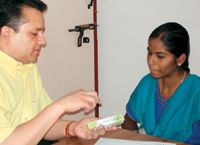- Acne
- Actinic Keratosis
- Aesthetics
- Alopecia
- Atopic Dermatitis
- Buy-and-Bill
- COVID-19
- Case-Based Roundtable
- Chronic Hand Eczema
- Chronic Spontaneous Urticaria
- Drug Watch
- Eczema
- General Dermatology
- Hidradenitis Suppurativa
- Melasma
- NP and PA
- Pediatric Dermatology
- Pigmentary Disorders
- Practice Management
- Precision Medicine and Biologics
- Prurigo Nodularis
- Psoriasis
- Psoriatic Arthritis
- Rare Disease
- Rosacea
- Skin Cancer
- Vitiligo
- Wound Care
Article
Community service a responsibility for 'privileged' derm
Amit Pandya, M.D., uses his knowledge of medicine and dermatology to carry out his life's missions.
Amit Pandya, M.D., uses his knowledge of medicine and dermatology to carry out his life's missions.

Minority advocate

In studying prevalence and impact of melasma in the Dallas-Fort Worth area, he found that skin disease was common among Hispanics and significantly impacts their quality of life.
Dr. Pandya joined the board of directors of the Skin of Color Society and Pigmentary Disorders Academy. He also became the American Academy of Dermatology (AAD) representative to the Association of American Medical Colleges (AAMC), where he learned more about cultural competence and minority issues, and he gives yearly lectures on cultural competence and pigmentary disorders at AAD meetings.
Dr. Pandya tells the story of seeing a video on cultural competence training describing a patient from Afghanistan who spoke only Afghani. The man refused continuous IV infusion of a chemotherapeutic agent because it was important for him to be able to pray five times a day at his mosque, where he could not have any blood, stains or cuts on this body while praying. Another important aspect in understanding this patient is that, while he was the decision-maker for his whole family in his homeland, in the United States he was at the mercy of his youngest English-speaking daughter. Lack of awareness of these issues led to miscommunication between the patient and his doctors.
Obligated to know
Dr. Pandya says dermatologists are inundated with bad or weak information, and he is among those committed to setting records straight with evidence.
He knew, for example, that dermatologists were using chemical peels to treat melasma, yet he could not find good evidence to back up the practice. So, he and colleagues conducted a blinded, placebo-controlled study investigating whether a mild glycolic acid peel was truly a melasma remedy.
"The impact is profound because the cost of a tube of depigmenting cream is much less than a series of chemical peels. More importantly, we are obligated to recommend treatments that have good evidence of efficacy as we counsel our patients," he says.
The researchers peeled half the faces of 19 subjects and used a depigmenting cream on both sides. They found that both sides improved equally and the peel offered no benefit.
"Every type of treatment that we use should be based on the best available data. If we do not have data, then dermatologists, and particularly academic dermatologists, are obligated to do studies to push the envelope of dermatology forward and improve clinical dermatologic science," he says. "I hope that the recent push by the National Institutes of Health (NIH) to improve clinical trials results in more evidence based information for dermatologists."
He and colleagues found quite the opposite when they studied light therapy's effect on vitiligo.
Newsletter
Like what you’re reading? Subscribe to Dermatology Times for weekly updates on therapies, innovations, and real-world practice tips.















